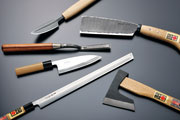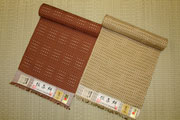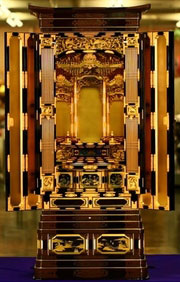Yamagata and more
- Sort by
- Popularity
- Name
-
Imari ware/Arita ware Imari yaki Arita yaki
- Ceramic
- Saga

Imari ware and Arita ware are both porcelain produced around the town of Arita, in the Saga prefecture. Imari ware and Arita ware are light and delicate and both have excellent durability because their porcelain is produced from porcelain stone. T…
View more
-
Hagi ware Hagi yaki
- Ceramic
- Yamaguchi

Hagi ware (called Hagi yaki in Japanese) is a form of porcelain produced mainly in the city of Hagi in Yamaguchi prefecture. Hagi ware is rarely decorated, remaining as simple as possible to make the most of the features of the clay. This simplici…
View more
-
Karatsu ware Karatsu yaki
- Ceramic
- Saga

Karatsu ware (called Karatsu yaki) is a form of porcelain produced in the Saga and Nagasaki prefectures. This traditional craft has been produced since the 16th century in various forms, including tea bowls. One of the most notable features of Kar…
View more
-
Ojiya chijimi textiles Ojiya chijimi
- Woven textiles
- Niigata

Ojiya chijimi textiles (called Ojiya chijimi in Japanese) is a handicraft produced from ramie in the area around the city of Ojiya in Niigata prefecture. Ramie is a tall plant of the nettle family that has been used to make cloth for centuries. R…
View more
-
Satsuma ware Satsuma yaki
- Ceramic
- Kagoshima

Satsuma ware (called satsuma yaki in Japanese) is a form of porcelain produced in Kagoshima prefecture. There are three types of Satsuma ware: white, black, and porcelain. Then there are six categories: tateno, ryumonji, naeshirogawa, nishimochida…
View more
-
Iga ware Iga yaki
- Ceramic
- Mie

Iga ware (called iga yaki in Japanese) is a form of porcelain produced in the area around the city of Iga, Mie prefecture. The main production areas of this craft are the sites of Makiyama and Marubashira in the Ayama district of Iga and the excel…
View more
-
Beppu bamboo crafts Beppu take zaiku
- Wood, bamboo crafts
- Oita

Beppu take-zaiku are bamboo crafts produced in the city of Beppu, Oita prefecture mainly from odake bamboo* grown and harvested locally. This craft is entirely handmade and uses a distinctive range of basic weaving techniques. It is also the only …
View more
-
Shiozawa tsumugi silk Shiozawa tsumugi
- Woven textiles
- Niigata

Shiozawa tsumugi is a silk textile produced in the former town of Shiozawa (now a part of the city of Minamiuonuma), Niigata prefecture. The area is known for its heavy snowfall and wet winter climate which are ideal for weaving. Echigo jofu, a fa…
View more
-
Akama inkstone Akama suzuri
- Writing tools
- Yamaguchi

Akama inkstone (called Akama suzuri in Japanese) is produced around the cities of Shimonoseki and Ube in Yamaguchi prefecture. A type of stone called akama, an ideal material for producing the inkstones, is used for Akama inkstone. Therefore this …
View more
-
Tendo Japanese chess pieces Tendo shogi koma
- Other crafts
- Yamagata

Tendo Japanese chess pieces (called Tendo shogi koma in Japanese) are made in the cities of Tendo, Yamagata, and Murayama in Yamagata prefecture. Production is thought to have begun in Tendo back during the Edo period (1603-1868) and now the city …
View more
-
Yamagata cast iron Yamagata imono
- Metal works
- Yamagata

Yamagata cast iron (called Yamagata imono in Japanese) is produced in the city of Yamagata, Yamagata prefecture. At first, metal fittings, Buddhist statues, and daily use items were made. Then, as skills and techniques were developed, iron kettles…
View more
-
Ouchi lacquerware Ouchi nuri
- Lacquerware
- Yamaguchi

Ouchi lacquerware (called Ouchi nuri in Japanese) is produced around the city of Yamaguchi, in Yamaguchi prefecture. This craft emerged under the Ouchi clan, which boasted significant influence and power in the region during the Muromachi period (…
View more
-
Suzuka inksticks Suzuka sumi
- Writing tools
- Mie

Suzuka inksticks (called Suzuka sumi in Japanese) are made in the city of Suzuka, Mie prefecture. This is the only inkstick craft registered as a Traditional Japanese Craft. Just one company, Shinseido, continues to produce Suzuka inksticks. This …
View more
-
Yokkaichi-banko ware Yokkaichi banko yaki
- Ceramic
- Mie

Yokkaichi banko ware (called Yokkaichi banko yaki in Japanese) is a form of ceramic ware produced in the city of Yokkaichi, Mie prefecture. For a long time, items for everyday use like teacups and plates, as well as pieces of art like vases have b…
View more
-
Hon-shiozawa silk Hon shiozawa
- Woven textiles
- Niigata

Hon-shiozawa is a textile produced in the former town of Shiozawa (now a part of the city of Minamiuonuma), Niigata prefecture. It is one of the textiles that represent the region, which is famous for linen and silk textile production. This craft …
View more
-
Oitama tsumugi silk Oitama tsumugi
- Woven textiles
- Yamagata

Oitama tsumugi is a silk fabric produced in the Yonezawa, Hakutaka and Nagai regions of Oitama in southern Yamagata prefecture. The area was well-known for producing and exporting ramie, a tall plant of the nettle family that has been used to make…
View more
-
Ojiya tsumugi silk Ojiya tsumugi
- Woven textiles
- Niigata

Ojiya tsumugi is a silk fabric produced in the area around Ojiya, Niigata prefecture, which is a city known for heavy snow. Echigo jofu, a textile made of ramie, has been produced in this area for over a thousand years. As new weaving techniques …
View more
-
Honba oshima tsumugi silk Honba oshima tsumugi
- Woven textiles
- Kagoshima

Honba Oshima Tsumugi is a fabric made on the island of Amami, Kagoshima prefecture. It is one hundred percent plain silk that has been dyed and made on handlooms like shime-bata or te-bata. This textile has deep, muted tones as it is dyed with ye…
View more
-
Niigata lacquerware Niigata shikki
- Lacquerware
- Niigata

Niigata Lacquerware (called Niigata Shikki in Japanese) is a form of lacquerware produced in the area around the city of Niigata, Niigata prefecture. This craft has various coating techniques such as hana-nuri, ishime-nuri, nishiki-nuri, isokusa-n…
View more
-
Iga braided cords Iga kumihimo
- Other textiles
- Mie

Iga Braided Cords, called Iga Kumihimo in Japanese, are made in Mie prefecture. Mainly silk threads are used, often in combination with gold and silver threads. This craft is known for rich silk threads, being dyed in a vibrant range of colors, an…
View more
-
Kamo traditional chest Kamo kiri tansu
- Wood, bamboo crafts
- Niigata

Kamo Kiri Tansu are chests of drawers made of paulownia wood that are produced in and around the city of Kamo, Niigata prefecture. Today, a majority of all paulownia chests made in Japan are produced in Kamo. This craft can keep clothes safe from …
View more
-
Kawanabe Buddhist altar Kawanabe butsudan
- Household Buddhist altars
- Kagoshima

Kawanabe Buddhist Altars (called Kawanabe Butsudan in Japanese) are made in the Kawanabe area of Minamikyushu, Kagoshima prefecture. There is a specific type of altar called gamado that is unique to this craft. Gama means cave in the Kagoshima dia…
View more
-
Murakami carved lacquerware Murakami kibori tsuishu
- Lacquerware
- Niigata

Murakami Carved Lacquerware (called Murakami Kibori Tsuishu in Japanese) is produced in the area around Murakami, Niigata prefecture. The region, which was formerly the Murakami domain, has been famous for its production of natural lacquer since t…
View more
-
Tsubame-tsuiki copperware Tsubame tsuiki doki
- Metal works
- Niigata

Tsubame-tsuiki Copperware (called Tsubame Tsuiki Douki in Japanese) is a type of metalware made on the outskirts of Tsubame, Niigata prefecture. Since the middle of the Edo period (1603-1868), kettles and other crafts have been produced from coppe…
View more
-
Ise paper stencil printing Ise katagami
- Industrial art materials and tools
- Mie

The Japanese name of Ise Paper Stencil Printing is Ise Katagami. Katagami means paper stencil. Today this craft is mostly produced in the city of Suzuka in Mie prefecture. They are an important part of textile dyeing. For many years, such stencils…
View more
-
Uetsu tilia bark cloth Uetsu shinafu
- Woven textiles
- Yamagata

Uetsu Shinafu is a textile produced in the area of Sekikawa, Tsuruoka, Yamagata prefecture, and Sanpoku, Murakami, Niigata prefecture. The names of the neighboring prefectures of Yamagata (Uzen) and Niigata (Echigo) are combined and called Uetsu, …
View more
-
Echigo-sanjo cutlery Echigo sanjo uchihamono
- Metal works
- Niigata

Echigo-Sanjo Uchihamono are hammer-forged blades produced in Sanjo City, Niigata prefecture. Unlike modern blades made using the stamp pressing and polishing techniques developed after the second world war, these blades are produced by hand-hammer…
View more
-
Tokamachi traditional resist-dyed textiles Tokamachi gasuri
- Woven textiles
- Niigata

Tokamachi Gasuri is a fabric produced in Tokamachi City and around Tsunanmachi in Nakauonuma, Niigata Prefecture. This area has heavy snow in the winter and is in a basin, so the climate and geographical features are all suitable for fabric produc…
View more
-
Yamagata Buddhist altar Yamagata butsudan
- Household Buddhist altars
- Yamagata

Yamagata Butsudan are Buddhist altars mainly made in Yamagata City, Tendo City, Obanazawa City, and Sakata City, Yamagata Prefecture, which distinguishes the prefecture as the largest center of altar production in the Tohoku region. Kichibei HOSHI…
View more
-
Nagaoka Buddhist altar Nagaoka butsudan
- Household Buddhist altars
- Niigata

Nagaoka Butsudan are Buddhist altars and altar fittings produced in and around Nagaoka City, Niigata Prefecture. Using traditional techniques that were developed in the 17th century, they are also actively producing innovative designs that suit a …
View more































































































































































































































































































